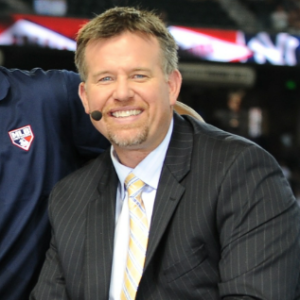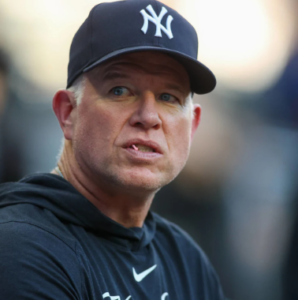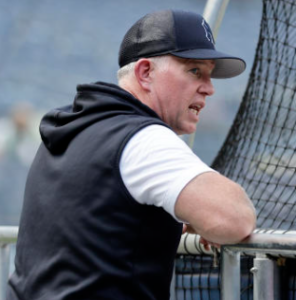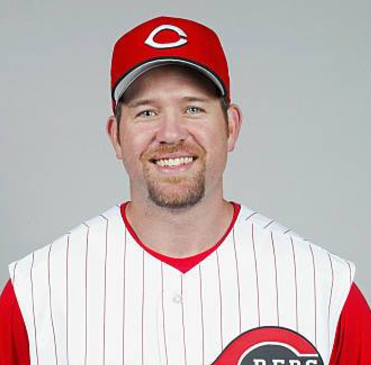The Golden At-Bat Rule represents a bold attempt to modernize baseball, prioritizing excitement and engagement over rigid adherence to tradition
Whether it becomes a permanent fixture or fades into obscurity will depend on how the baseball community balances its love for the sport’s history with its desire to remain relevant in a rapidly changing world.
One thing is certain: the conversation surrounding the Golden At-Bat Rule has already succeeded in energizing debates about the future of baseball.
While the Golden At-Bat Rule remains a concept for now, its potential to redefine baseball’s appeal is undeniable. Whether it’s implemented or not, the conversation it has sparked highlights a growing recognition of the need for change.
Sean Casey’s vision could be the blueprint for MLB’s future—a sport that balances its timeless charm with the dynamic energy of a new generation.

Also Read: Fernando Valenzuela (Baseball): Who Was He? Bio, Career, Legacy, Wife, Family and More
Table of Contents
Sean Casey: The “Golden At-Bat Rule”
Revolution or Overreach?
MLB Commissioner Rob Manfred’s recently proposed “Golden At-Bat Rule” has set the baseball world ablaze with debate.1
Fans, analysts, and players alike are wrestling with the potential ramifications of this bold idea.
Designed to inject excitement and guarantee high-stakes matchups, the rule permits managers to send any hitter to the plate at any time during the game, regardless of the batting order.
While the idea is still in the discussion phase, its implications for the sport’s traditions and strategies are profound.
Deep dive inside the Golden At-Bat convo inside #TheMayorsOffice pod today!
Apple: https://t.co/Z3CLBdWF35
Spotify: https://t.co/HgM99TqKK9
YouTube: https://t.co/Pycmy0iErJ pic.twitter.com/Wm3Zro360X— Sean Casey (@TheMayorsOffice) December 4, 2024
What Is the “Golden At-Bat Rule”?
The premise of the Golden At-Bat Rule is simple but game-changing. Imagine a star slugger like Aaron Judge striking out early in the ninth inning with his team trailing.
Under the proposed rule, his manager, Aaron Boone, could send Judge back to the plate later in the inning to try again.
This unprecedented flexibility could alter the trajectory of games, allowing managers to lean on their top hitters in crucial moments. However, it raises questions about fairness and the integrity of baseball’s organic flow.
Supporters: A Guaranteed Moment of Drama
Proponents of the Golden At-Bat Rule argue that it could elevate the entertainment value of games, delivering the kind of thrilling moments fans crave. Cincinnati Reds Hall of Famer Sean Casey is one of the rule’s most vocal advocates.
“Every night, you’re guaranteed a moment,” Casey explained during an appearance on The Mayor’s Office. “You’re guaranteed a big moment of superstars going head-to-head. That’s not guaranteed in every baseball game right now.”
For Casey, the rule isn’t just about boosting viewership but also about creating unforgettable, superstar-driven showdowns akin to basketball’s reliance on marquee players in clutch situations.

Sean Casey: Baseball’s Evolution
Learning from Other Sports
Casey likened the Golden At-Bat Rule to transformative changes in other sports, such as the introduction of the three-point line in basketball.2
“The three-point line didn’t just change the game—it created legends,” he argued, citing players like Steph Curry and Larry Bird. “Did it mess with the record books? Yeah, it did. But it also made the game more exciting and accessible to fans.”
Similarly, the NFL has evolved by tweaking rules to favor offenses, resulting in higher-scoring games that appeal to modern audiences. Baseball, with its slower pace and declining viewership, could benefit from a comparable shift.
Critics: A Threat to Baseball’s Purity
Not everyone is on board with the idea. Critics of the Golden At-Bat Rule argue that it undermines baseball’s unique structure and the sanctity of the batting order, a core component of the sport.
One of the biggest concerns is the potential loss of strategic nuance. Managers currently need to plan around their lineup’s limitations, creating opportunities for lesser-known players to step up. Allowing repeated at-bats for star players could overshadow these moments, reducing the sport to a battle of a few key hitters.
Traditionalists worry that the rule could fundamentally alter baseball’s essence, turning it into a spectacle more akin to entertainment-focused sports like basketball or football.

A Clash with Baseball’s Record Books
- Baseball is deeply rooted in its history and statistical integrity. Critics question how the Golden At-Bat Rule might impact the sport’s revered records.
- For instance, how would repeated at-bats in a single inning affect stats like batting averages or home run totals? Would historical comparisons lose their validity if modern players benefit from additional opportunities to pad their numbers?
- Casey acknowledges these concerns but argues that evolution is inevitable. “Things happen in sports that are good for the game,” he said, emphasizing that baseball, like all sports, must adapt to remain relevant.
- From a strategic perspective, the Golden At-Bat Rule introduces both opportunities and challenges for managers.
- On one hand, it allows teams to maximize their offensive potential in high-stakes moments. On the other hand, it could create tension around player selection and team dynamics.
- For example, repeatedly sending a star player to the plate might demoralize bench players and disrupt team chemistry. Additionally, opposing teams would need to adapt their pitching strategies, potentially leading to more frequent pitching changes and longer games.

Sean Casey: Fans Reaction
Fan reactions to the Golden At-Bat Rule have been mixed. Supporters see it as an opportunity to breathe new life into the sport, guaranteeing marquee matchups and elevating star players.3
“I’d love to see more of my favorite players in clutch moments,” said one fan on social media. “Why not make the game more exciting?”
However, traditionalists remain skeptical. “Baseball is supposed to be about the team, not just the stars,” another fan countered. “This rule feels like it’s turning the game into a gimmick.”
Historical Precedents: Baseball’s Past Innovations
The Golden At-Bat Rule isn’t the first time baseball has faced controversy over potential rule changes. Innovations like the designated hitter (DH), instant replay, and pitch clocks were all met with resistance initially but eventually became integral to the game.
The introduction of the DH, for instance, sparked similar debates about tradition versus progress. Yet today, it’s hard to imagine baseball without it. Could the Golden At-Bat Rule follow a similar trajectory?
The Economics of Excitement
- Beyond its impact on gameplay, the Golden At-Bat Rule has significant economic implications. By ensuring more dramatic moments, the rule could attract larger audiences, boost TV ratings, and increase ticket sales.
- In an era where baseball competes with faster-paced sports and digital entertainment, these financial incentives may ultimately outweigh concerns about tradition.
- As the Golden At-Bat Rule remains in the discussion phase, its future is uncertain.
- MLB could experiment with the rule during Spring Training or in independent leagues, providing an opportunity to assess its impact before implementing it in regular-season games.
- This approach would allow players, managers, and fans to adapt to the idea gradually, minimizing resistance and refining the rule as necessary.

Also Read: Gunnar Henderson (Baseball): Highlights Key Factor for Orioles to Secure AL East Title
Sean Casey: Captivate Gen-Z Fans
As baseball evolves to keep pace with the shifting interests of its audience, one question looms large: how can the game capture the hearts of Gen Z? Sean Casey, former MLB star and broadcaster, believes he has an answer.
The Golden At-Bat Rule, a proposal that would inject electrifying moments into games, might be the key to captivating a generation raised on highlight reels and viral content.
The Golden At-Bat Rule suggests allowing a team to pick one player for a guaranteed at-bat in a critical moment, such as the ninth inning of a tied game.
Imagine Shohei Ohtani stepping to the plate with two outs and the bases loaded. This setup ensures dramatic moments tailor-made for highlight reels, giving fans a reason to tune in, even if just for the final innings.
For Casey, the concept aligns perfectly with the viewing habits of younger audiences. “We’re talking about creating viral, shareable moments,” he says, emphasizing how the rule could transform the narrative of baseball games.
Baseball’s Struggle to Keep Gen Z Engaged
Compared to previous generations, Gen Z consumes sports differently. With their preference for short-form content, highlight clips, and fast-paced action, baseball’s leisurely pace often struggles to hold their attention.
According to Casey, Major League Baseball (MLB) has recognized this shift. “They’re not doing this on a whim,” Casey explains. “They’re looking at analytics and understanding that younger fans crave excitement.”
The Golden At-Bat Rule could be the solution, bringing thrilling, game-defining moments to the forefront.
In today’s sports landscape, highlight reels are king. They dominate social media platforms, turning standout plays into viral phenomena. While basketball and football thrive in this format, baseball lags behind due to its unpredictable nature and slower tempo.
Casey points out that baseball’s existing moments of drama—walk-off home runs, grand slams, and no-hitters—already attract attention. The Golden At-Bat Rule would ensure more of these moments, delivering the “wow factor” Gen Z craves.

Sean Casey: Theo Epstein’s Perspective on Baseball’s Challenges
Theo Epstein, former MLB executive and architect of multiple championship teams, shares Casey’s concerns about baseball’s waning appeal to younger fans.
Casey recalls Epstein telling him, “My kids don’t necessarily love baseball, but if the Golden At-Bat happened, they’d be on MLB.com the next morning to watch.”
This anecdote underscores a critical point: while Gen Z might not watch full games, they’re highly likely to engage with curated, dramatic content. The Golden At-Bat Rule could fill this niche, drawing casual viewers back into the baseball fold.
Proposals like the Golden At-Bat Rule inevitably face pushback from purists who cherish baseball’s traditions. Critics argue that the sport’s charm lies in its unpredictability and timeless pace.
However, Casey believes that innovation and tradition can coexist. “You’re not changing the fundamentals,” he insists. “You’re just adding a layer of excitement.” For Casey, the rule isn’t about undermining baseball’s core but enhancing its appeal for the next generation.
Success Stories of Rule Changes in MLB
Baseball has seen rule changes before, many of which initially faced skepticism but ultimately revitalized the game.
The pitch clock, for example, has significantly sped up games, addressing complaints about baseball’s slow pace.
The universal designated hitter (DH) rule brought offensive firepower to the National League.
The Golden At-Bat Rule could follow in these footsteps, becoming a game-changer that wins over even the staunchest critics.
While the rule’s appeal is clear, its implementation could raise logistical questions. Who decides when to invoke the Golden At-Bat? Would it be limited to specific innings or game situations? Could it disrupt the natural flow of the game?
MLB would need to carefully consider these factors to ensure the rule enhances drama without overshadowing the sport’s integrity. Yet Casey remains optimistic, arguing that “proper planning can make this work seamlessly.”
Also Read: Trevor Bauer (Baseball): Bio, Wiki, Career, Controversy, Pitching Style And More Explained




